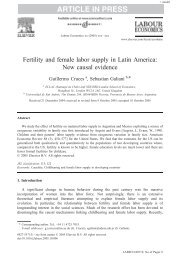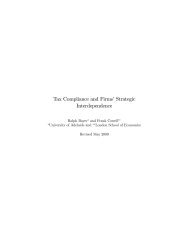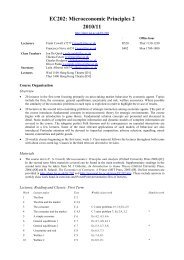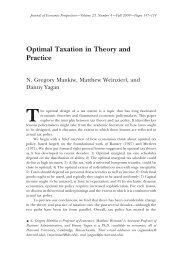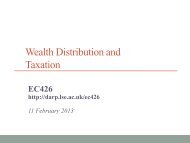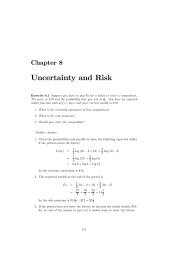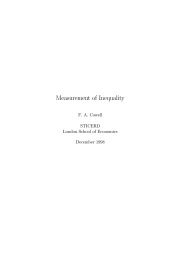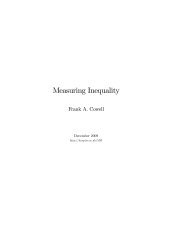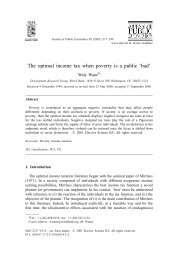- Page 1: Measuring InequalityFrank A. Cowell
- Page 6 and 7: viLIST OF TABLES
- Page 9 and 10: LIST OF FIGURESix5.17 The Atkinson
- Page 13 and 14: xiiidating the literature notes and
- Page 15 and 16: Chapter 1First Principles“It is b
- Page 17: 1.1. A PREVIEW OF THE BOOK 31.1 A p
- Page 20 and 21: 6 CHAPTER 1. FIRST PRINCIPLESthe po
- Page 22 and 23: 8 CHAPTER 1. FIRST PRINCIPLEStype
- Page 24 and 25: 10 CHAPTER 1. FIRST PRINCIPLESequiv
- Page 26 and 27: 12 CHAPTER 1. FIRST PRINCIPLESmark
- Page 28 and 29: 14 CHAPTER 1. FIRST PRINCIPLESmonth
- Page 33 and 34: 2.1. DIAGRAMS 19UK Income Before Ta
- Page 37 and 38: 2.2. INEQUALITY MEASURES 23Figure 2
- Page 39 and 40: 2.2. INEQUALITY MEASURES 25Figure 2
- Page 41 and 42: 2.2. INEQUALITY MEASURES 27the indi
- Page 43: 2.2. INEQUALITY MEASURES 29source.
- Page 47 and 48: 2.3. RANKINGS 33Figure 2.10: Rankin
- Page 49 and 50: 2.3. RANKINGS 35Figure 2.12: Change
- Page 51 and 52: 2.5. QUESTIONS 37[£ 2000,£ 3000]
- Page 53 and 54: Chapter 3Analysing Inequality“He
- Page 55 and 56: 3.1. SOCIAL-WELFARE FUNCTIONS 41 Th
- Page 57 and 58: 3.1. SOCIAL-WELFARE FUNCTIONS 43val
- Page 59 and 60: 3.1. SOCIAL-WELFARE FUNCTIONS 45U'
- Page 61 and 62: 3.1. SOCIAL-WELFARE FUNCTIONS 47Fig
- Page 63 and 64: 3.2. SWF-BASED INEQUALITY MEASURES
- Page 65 and 66: 3.2. SWF-BASED INEQUALITY MEASURES
- Page 67 and 68: 3.3. INEQUALITY AND INFORMATION THE
- Page 69 and 70: 3.3. INEQUALITY AND INFORMATION THE
- Page 71 and 72: 3.3. INEQUALITY AND INFORMATION THE
- Page 73 and 74: 3.3. INEQUALITY AND INFORMATION THE
- Page 75 and 76: 3.4. BUILDING AN INEQUALITY MEASURE
- Page 77 and 78: 3.4. BUILDING AN INEQUALITY MEASURE
- Page 79 and 80: 3.5. CHOOSING AN INEQUALITY MEASURE
- Page 81 and 82: 3.5. CHOOSING AN INEQUALITY MEASURE
- Page 83 and 84: 3.5. CHOOSING AN INEQUALITY MEASURE
- Page 85 and 86: 3.7. QUESTIONS 71Even if these assu
- Page 87 and 88: 3.7. QUESTIONS 73Which of these app
- Page 89 and 90: Chapter 4Modelling Inequality“I d
- Page 91 and 92: 4.2. THE LOGNORMAL DISTRIBUTION 77c
- Page 93 and 94: 4.2. THE LOGNORMAL DISTRIBUTION 79F
- Page 95 and 96:
4.2. THE LOGNORMAL DISTRIBUTION 81F
- Page 97 and 98:
4.2. THE LOGNORMAL DISTRIBUTION 83t
- Page 99 and 100:
4.3. THE PARETO DISTRIBUTION 85Figu
- Page 101 and 102:
4.3. THE PARETO DISTRIBUTION 87Figu
- Page 103 and 104:
4.3. THE PARETO DISTRIBUTION 89Figu
- Page 105 and 106:
4.4. HOW GOOD ARE THE FUNCTIONAL FO
- Page 107 and 108:
4.4. HOW GOOD ARE THE FUNCTIONAL FO
- Page 109 and 110:
4.5. QUESTIONS 95Figure 4.12: Paret
- Page 111 and 112:
4.5. QUESTIONS 978.(b) Repeat part
- Page 113 and 114:
Chapter 5From Theory to Practice“
- Page 115 and 116:
5.1. THE DATA 101Figure 5.1: Freque
- Page 117 and 118:
5.1. THE DATA 103Figure 5.2: Dispos
- Page 119 and 120:
5.1. THE DATA 105those where tax re
- Page 121 and 122:
5.1. THE DATA 107goods’ prices wi
- Page 123 and 124:
5.2. COMPUTATION OF THE INEQUALITY
- Page 125 and 126:
5.2. COMPUTATION OF THE INEQUALITY
- Page 127 and 128:
5.2. COMPUTATION OF THE INEQUALITY
- Page 129 and 130:
5.2. COMPUTATION OF THE INEQUALITY
- Page 131 and 132:
5.2. COMPUTATION OF THE INEQUALITY
- Page 133 and 134:
5.2. COMPUTATION OF THE INEQUALITY
- Page 135 and 136:
5.2. COMPUTATION OF THE INEQUALITY
- Page 137 and 138:
5.2. COMPUTATION OF THE INEQUALITY
- Page 139 and 140:
5.3. APPRAISING THE CALCULATIONS 12
- Page 141 and 142:
5.3. APPRAISING THE CALCULATIONS 12
- Page 143 and 144:
5.3. APPRAISING THE CALCULATIONS 12
- Page 145 and 146:
5.4. SHORTCUTS: FITTING FUNCTIONAL
- Page 147 and 148:
5.4. SHORTCUTS: FITTING FUNCTIONAL
- Page 149 and 150:
5.4. SHORTCUTS: FITTING FUNCTIONAL
- Page 151 and 152:
5.4. SHORTCUTS: FITTING FUNCTIONAL
- Page 153 and 154:
5.5. INTERPRETING THE ANSWERS 139fo
- Page 155 and 156:
5.5. INTERPRETING THE ANSWERS 141Is
- Page 157 and 158:
5.6. A SORT OF CONCLUSION 143by sam
- Page 159 and 160:
5.7. QUESTIONS 1451st 2nd 3rd 4th 5
- Page 161 and 162:
5.7. QUESTIONS 1471980 1983 1986y O
- Page 163 and 164:
Appendix ATechnical AppendixA.1 Ove
- Page 165 and 166:
A.2. MEASURES AND THEIR PROPERTIES
- Page 167 and 168:
A.3. FUNCTIONAL FORMS OF DISTRIBUTI
- Page 169 and 170:
A.3. FUNCTIONAL FORMS OF DISTRIBUTI
- Page 171 and 172:
A.3. FUNCTIONAL FORMS OF DISTRIBUTI
- Page 173 and 174:
A.3. FUNCTIONAL FORMS OF DISTRIBUTI
- Page 175 and 176:
A.5. DECOMPOSITION OF INEQUALITY ME
- Page 177 and 178:
A.5. DECOMPOSITION OF INEQUALITY ME
- Page 179 and 180:
A.5. DECOMPOSITION OF INEQUALITY ME
- Page 181 and 182:
A.6. NEGATIVE INCOMES 167The possib
- Page 183 and 184:
A.7. ESTIMATION PROBLEMS 169Now con
- Page 185 and 186:
A.7. ESTIMATION PROBLEMS 171f(y)w=0
- Page 187 and 188:
A.7. ESTIMATION PROBLEMS 173give th
- Page 189 and 190:
A.8. USING THE WEBSITE 175Table Fig
- Page 191 and 192:
Appendix BNotes on Sources andLiter
- Page 193 and 194:
B.2. CHAPTER 2 179sure of poverty a
- Page 195 and 196:
B.2. CHAPTER 2 181viation, used by
- Page 197 and 198:
B.3. CHAPTER 3 183analogy between r
- Page 199 and 200:
B.3. CHAPTER 3 185Inequality and in
- Page 201 and 202:
B.4. CHAPTER 4 187properties (Aitch
- Page 203 and 204:
B.4. CHAPTER 4 189prevailing. Berna
- Page 205 and 206:
B.5. CHAPTER 5 191and Survey of Eco
- Page 207 and 208:
B.5. CHAPTER 5 193Appraising the ca
- Page 209 and 210:
B.6. TECHNICAL APPENDIX 195inequali
- Page 211 and 212:
BibliographyAaberge, R. (2000). Cha
- Page 213 and 214:
BIBLIOGRAPHY 199Arnold, B. C. (1983
- Page 215 and 216:
BIBLIOGRAPHY 201Bauer, P. T. and A.
- Page 217 and 218:
BIBLIOGRAPHY 203Borooah, V. K., P.
- Page 219 and 220:
BIBLIOGRAPHY 205Chakravarty, S. R.
- Page 221 and 222:
BIBLIOGRAPHY 207Cowell, F. A. (2008
- Page 223 and 224:
BIBLIOGRAPHY 209Davies, J. B. and A
- Page 225 and 226:
BIBLIOGRAPHY 211Feldstein, M. (1998
- Page 227 and 228:
BIBLIOGRAPHY 213Giles, D. E. A. (20
- Page 229 and 230:
BIBLIOGRAPHY 215Horrace, W., J. Mar
- Page 231 and 232:
BIBLIOGRAPHY 217Kloek, T. and H. K.
- Page 233 and 234:
BIBLIOGRAPHY 219Levine, D. and N. M
- Page 235 and 236:
BIBLIOGRAPHY 221Morgan, J. N., M. H
- Page 237 and 238:
BIBLIOGRAPHY 223Pigou, A. C. (1952)
- Page 239 and 240:
BIBLIOGRAPHY 225Saposnik, R. (1983)
- Page 241 and 242:
BIBLIOGRAPHY 227Simon, H. A. (1957)
- Page 243 and 244:
BIBLIOGRAPHY 229Tuomala, M. (1990).
- Page 245 and 246:
IndexAaberge, R., 180, 181Abel-Smit
- Page 247 and 248:
INDEX 233Davies, J.B., 184, 193Davi
- Page 249 and 250:
INDEX 235Incomecomparability, 5, 6,
- Page 251 and 252:
INDEX 237Luo, R., 192Luxembourg Inc
- Page 253 and 254:
INDEX 239Rein, M., 177Relative mean
- Page 255:
INDEX 241Young, A.A., 181Yu, L., 19



